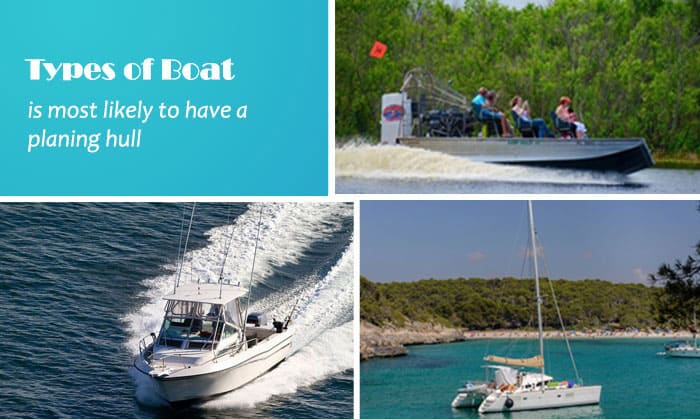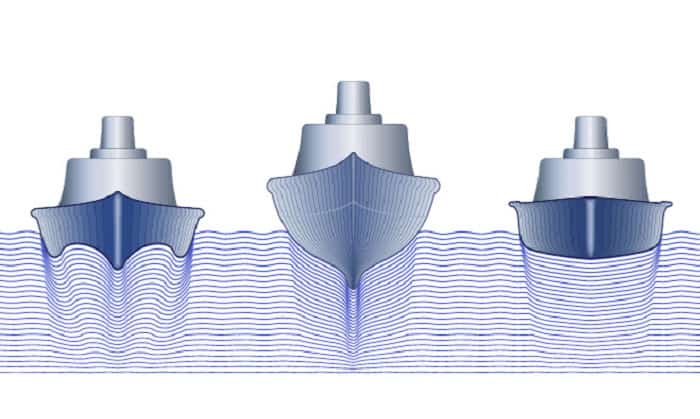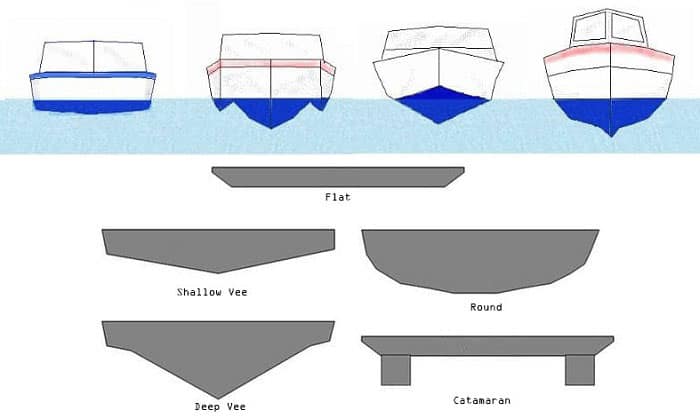Those who are concerned about boat hull design may think about ‘What type of boat is most likely to have a planing hull?’ Typically, small motor-operated vessels like personal watercraft and small sailboats have planing hulls.
Due to this hull, these vessels can travel at a fast pace. You’ll see them riding the water instead of pushing it aside. They climb the water when moving fast but they become displacement hulls over slow speed or at rest.
I know that these boats with planing hulls look cool when they move at a high speed. But you need to learn more about them in the following statements.
Table of Contents
Planing Hull vs Displacement Hull
Planing Hull
Regardless of the weight, a boat with a planing hull can ride the waters. It has a flat hull design to give access to the plane. Based on its functionality, the flatter the bottom, the better!
Flatter hulls only need minimal power to acquire high speed. However, there’s a trade-off in handling as flat hulls are not great on rough water. Most planing boats have shallow V-shaped to overcome choppy waters.
This type of boat hulls is prominent among modern boats. Some even have ‘stepped’ hulls for additional lift.
Displacement Hull
You can discern a displacement hull through its rounded bottom and teardrop form from running bow to stern. As implied in its name, it displaces water equal to the boat’s weight.
It is also efficient and you can see it on range cruising vessels like trawlers and some sailboats. There’s a restriction on the speed of this hull design, and it’s the square root of the waterline length multiplied by 1.34. Based on this calculation, a 64-foot boat is allowed to have a top speed of a bit over 10 knots.
Planing Hulls and its Various Types
Typically, fishing boats have planing hulls as they are small and power-driven. In most parts, they ride the water and don’t plow it. Thus, only less fuel is consumed. However, you can sometimes have a rougher and unstable ride while they bounce on the waves.
There are various types of planing hulls with pros and cons like listed as follow:
1. Flat Bottom Hull
This is typically on smaller, open boats with a shallow draft. It’s a type of hull that is effective for fishing in ponds, lakes, and slow-moving rivers. The best examples are dingy boats and rowboats.
You can depend on its stability in calm waters. However, take note of its broad bow that causes a rough ride. A good amount of power is needed to make it move. Boats with flat bottom haul are only exclusive with low horsepower motors. Unfortunate circumstances may come as these boats may bank in roll during sharp turns.
2. Round Bottom Hull
This type of hull is usually utilized as a displacement hull on some car-top boats, tenders, and dinghies. The exact representations for this are kayak and canoe. They give you a soft ride but also tend to rock back and forth.
The purpose for the rounded bottom is the key for boats to easily move on the water at a lower speed. Furthermore, it limits the drag on the vessels. The downside is being unstable and requiring a stabilizer or a deep keel to limit rolling.
3. Multi-hull
Fishing boats with multi-hull have more than a single hull for planing and displacement. An air pocket forms in the middle of the hull, so these boats can effortlessly get on the plane.
You can find this kind of hull on pontoons and catamarans. They have a wide beam that creates great stability and easy travel on the waters. If you take notice, the propeller on this planing hull is not completely submerged.
When moving with higher top-end speed, multi-hull boats need a high pitch and holding ability. Also, a large area is essential when they turn.
4. Deep V Hull
A deep V hull is ideally for wavy waters and traveling farther offshore. It’s a common design but some modifications were made by manufacturers. Anyway, it’s what you see on fiberglass motorboats and powerboats.
It is easy to control a fishing boat with a deep V hull at a slow speed. The V part slices through the water to give you a good ride even on rough waters. Due to its shallow draft, it’s perfect when fishing on small rivers and lakes.
Just be careful when doing sharp turns as it might roll or bank. This hull can be at the same speed as the flat bottom but it requires more power.
Read more: V-hull vs flat bottom: what is the difference?
5. Cathedral Hull
Modern boats that are power-driven have cathedral hulls, which are the results of modifying tri-hulls. It’s designed for stability as there are two or more hulls attached for extra width.
An air pocket also exists in the middle section, so the boat can easily be on the plane. The bow on this hull has increased surface, so expect a rougher ride on choppy waters. There will be a lot of sprays too because of the pounding of side hulls.
Size Limits on Planing Hull
As it is defined that the planing hull is ideal for smaller boats, there’s a limit on the size of the boat. It’s not good to upscale as cube square law brings out defects. Practically, vessels with planing hulls are in the size range of 20 to 24 meters.
The weight and planing surface should be balanced. When doubling the length, the increase in weight is a whopping eight times. In this case, the planing force only increases four times and is not enough for the weight that went up eight times.
This is the disadvantage of every planing hull. It can never be in massive ship size as the planing force won’t be enough to support the increase of weight.
The Importance of Volume Distribution When Controlling a Boat with a Planing Hull
When volume is contained in the boat’s cockpit, the ends turn thinner and flatter. The sportier look is gained if the stern and the bow are the main parts that engage into the water.
In this aspect, squirt-like movements are a breeze for paddlers. Thus, it turns out that the proportional weight of river running boats is accommodated around the cockpit. But less volume on the stern and bow can be detrimental.
Vessels with the evenly distributed volume on the bow and stern are under control and can resurface more quickly. They also have resistance against burying off the ledges and punching holes.
Moreover, the backend effect can happen if there’s a low volume on the stern. You can find these advantages in creek boats but unfortunately, they’re not present in river running boats.
Takeaway
What type of boat is most likely to have a planing hull? Ideally, smaller vessels are the answer to this question. The planing force can carry the weight of these boats that can easily ride the waters.
Although boats with planing hulls look cool when traversing the water, you also have to be aware of its downside. Thus, be careful when maneuvering them. There are various hulls, and not one can be perfect in everything.

“I am James Harvey – founder of Boating Basics Online. It is established with the drive to help out first-time boaters, which are those desiring to explore their way through the water. So if you are new to boating, start from here with me. “



